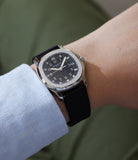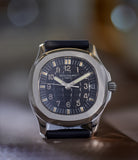The Aquanaut marked the beginning of a new generation of luxury sports watches for Patek Philippe, inspired by the unmistakeable lines of the Nautilus. In 1997, the manufacturer introduced the reference 5060, which was followed a few years later by the reference 5066, which added an open caseback to the original design.
You May Also Like
A watch for modernity
In 1996, Patek Philippe introduced the Aquanaut 5060S, one of their first attempts at repurposing the original Nautilus design.
With its precious metal case, smooth dial, Roman numerals and leather strap, it's understood that this piece was met with a rather muted reaction. As a result, one year later, Patek Philippe went further still and introduced the 5060A - with the “A” standing for “Acier”, which means steel in French. With its stainless-steel case, checkerboard dial and tropical strap, this is widely considered as the first Aquanaut ever made.
It is understood that the 5060 - in both gold and steel - was limited to 1,000 pieces, due to the number of movements which were available at the time. The stainless-steel variant was produced for a brief one year period, making these pieces as rare as they are significant. The 5060A displays a range of features only found on the earliest pieces, such as the closed caseback, tritium lume, cursive font on the date disc and 'Nautilus' signature on the clasp (as the Aquanaut was originally intended to be part of the Nautilus collection).
Its design elements were geared towards something much sportier and more contemporary than the manufacturer was then known for at the time. Though unconfirmed, rumour suggests that the model was first commissioned by high level military personnel, hence the utilitarian design and dial pattern reminiscent of a grenade. Ever since its introduction, the Aquanaut has only grown in appeal, with these early pieces reminding us of where it all began.





















































































































































































































